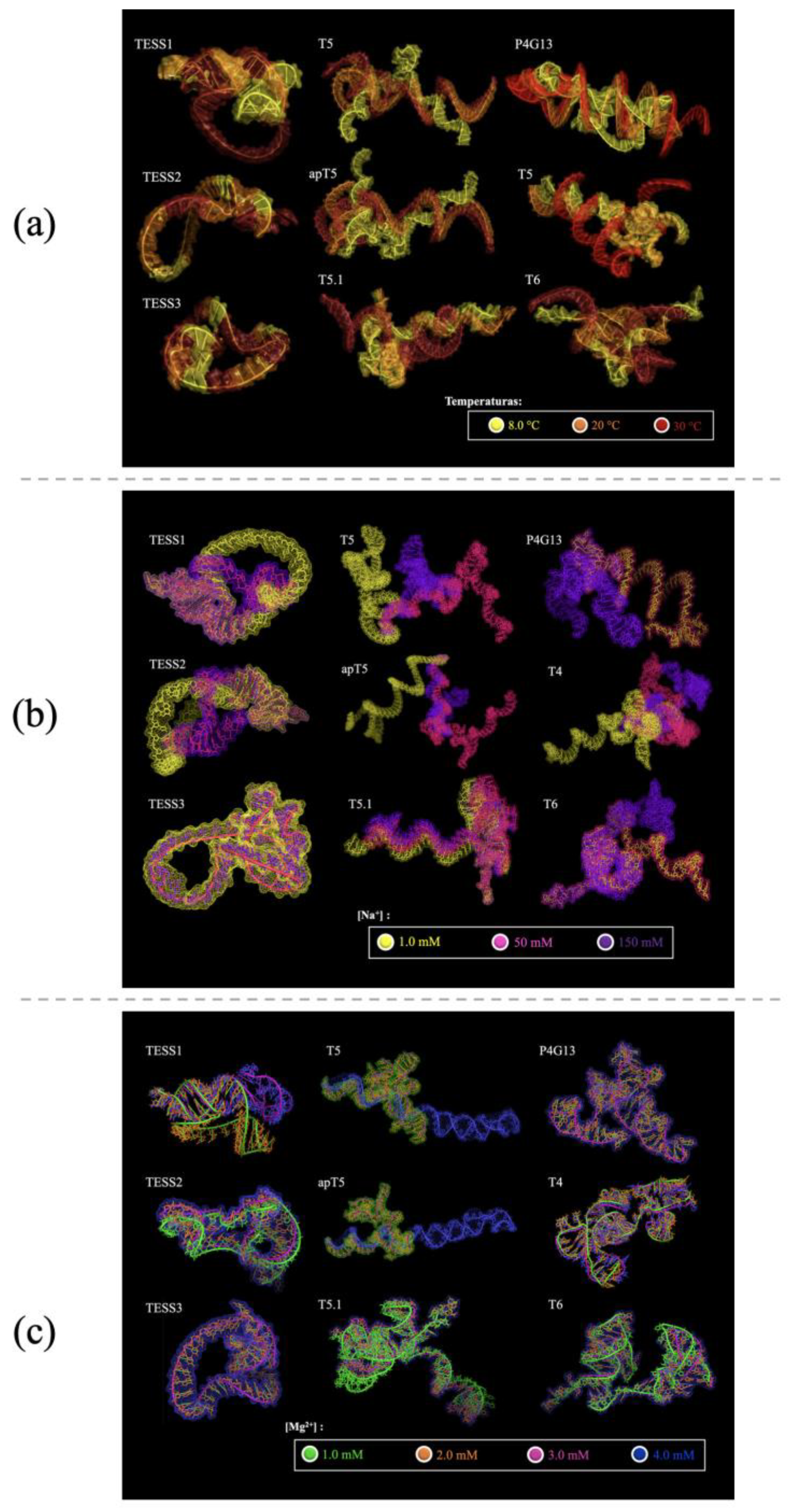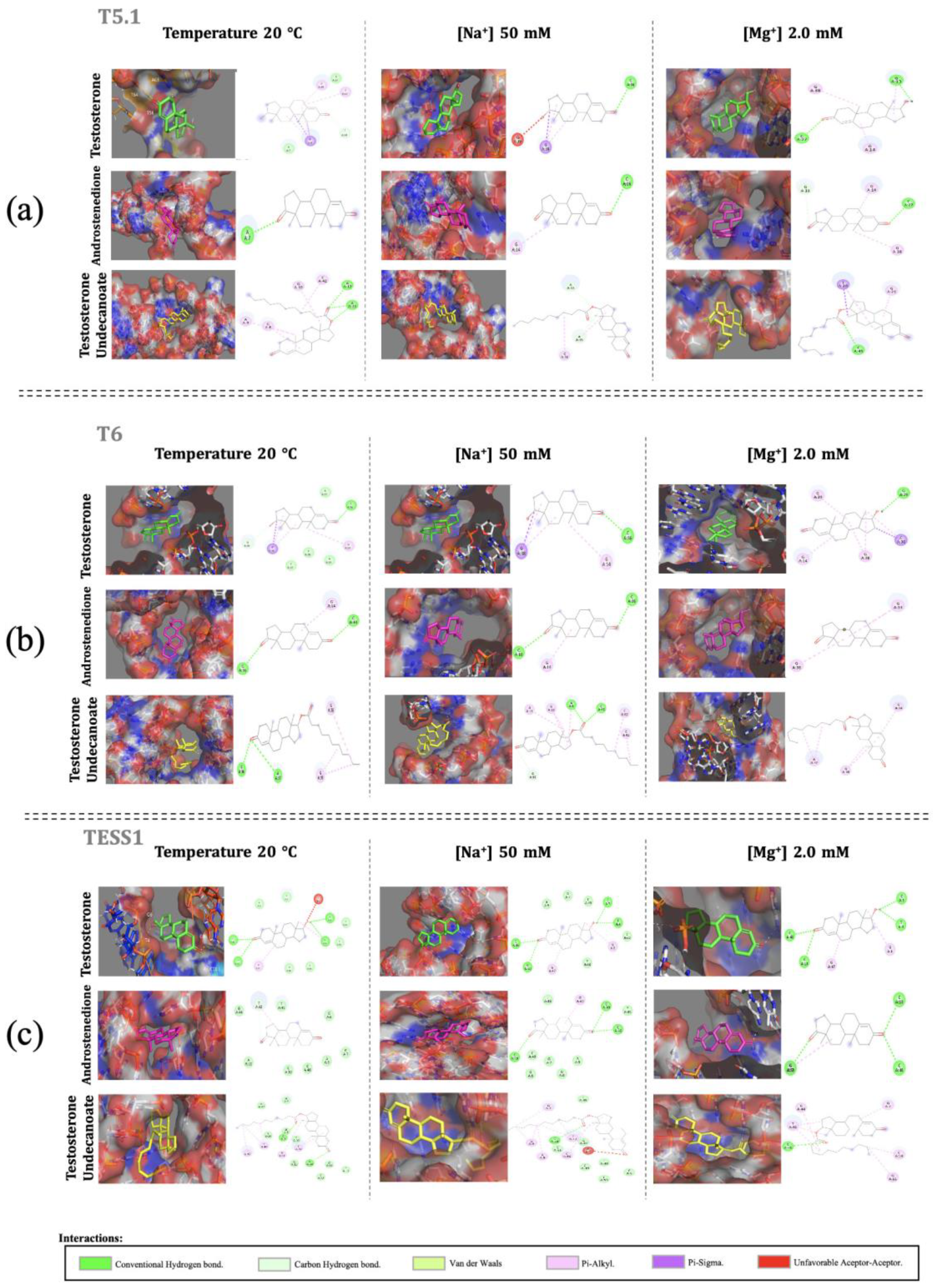In-Silico Evaluation of the Folding and Structural Stability of Aptamers for Application in the Design of a Biosensor for Testosterone Detection †
Abstract
:1. Introduction
2. Methods
2.1. Prediction of the Secondary Structure
2.2. Construction and Optimization of the Tertiary Structure
2.3. Molecular Docking
3. Results and Discussion
4. Conclusions
Author Contributions
Funding
Institutional Review Board Statement
Informed Consent Statement
Data Availability Statement
Conflicts of Interest
References
- Balasubramanian, A.; Thirumavalavan, N.; Srivatsav, A.; Yu, J.; Lipshultz, L.I.; Pastuszak, A.W. Testosterone Imposters: An Analysis of Popular Online Testosterone Boosting Supplements. J. Sex. Med. 2019, 16, 203–212. [Google Scholar] [CrossRef] [PubMed]
- Zamil, D.H.; Perez-Sanchez, A.; Katta, R. Acne related to dietary supplements. Dermatol. Online J. 2020, 26, 2. [Google Scholar] [CrossRef]
- Jędrejko, K.; Lazur, J.; Muszyńska, B. Risk Associated with the Use of Selected Ingredients in Food Supplements. Chem. Biodivers. 2021, 18, e2000686. [Google Scholar] [CrossRef]
- Sefah, K.; Phillips, J.A.; Xiong, X.; Meng, L.; Van Simaeys, D.; Chen, H.; Tan, W. Nucleic acid aptamers for biosensors and bio-analytical applications. Analyst 2009, 134, 1765. [Google Scholar] [CrossRef]
- Pan, C.; Qiu, J.; Wang, L.; Yan, Z.; Huang, W.; Zhang, D.; Zhan, X.; Shen, G. Colorimetric Aptasensor for Testosterone Detection Based on Aggregation of Gold Nanoparticles Induced by Cationic Surfactant. Aust. J. Chem. 2020, 74, 261–267. [Google Scholar] [CrossRef]
- Skouridou, V.; Schubert, T.; Bashammakh, A.S.; El-Shahawi, M.S.; Alyoubi, A.O.; O’Sullivan, C.K. Aptatope mapping of the binding site of a progesterone aptamer on the steroid ring structure. Anal. Biochem. 2017, 531, 8–11. [Google Scholar] [CrossRef] [PubMed]
- Yang, K.A.; Chun, H.; Zhang, Y.; Pecic, S.; Nakatsuka, N.; Andrews, A.M.; Worgall, T.S.; Stojanovic, M.N. High-Affinity Nucleic-Acid-Based Receptors for Steroids. ACS Chem. Biol. 2017, 12, 3103–3112. [Google Scholar] [CrossRef] [PubMed]
- O’Sullivan, C.K.; Alyoubi, A.O.; El-Shahawi, M.S.; Bashammakh, A.S.; Svobodova, M.; Betul Aktas, G.; Jauset-Rubio, M. One-Pot SELEX: Identification of Specific Aptamers against Diverse Steroid Targets in One Selection. ACS Omega 2019, 4, 20188–20196. [Google Scholar]
- Zuker, M. Mfold web server for nucleic acid folding and hybridization prediction. Nucleic Acids Res. 2003, 31, 3406–3415. [Google Scholar] [CrossRef] [PubMed]
- Laing, C.; Schlick, T. Computational approaches to RNA structure prediction, analysis, and design. Curr. Opin. Struct. Biol. 2011, 21, 306–318. [Google Scholar] [CrossRef]
- Trott, A.J.; Olson, A.J. AutoDock Vina: Improving the speed and accuracy of docking with a new scoring function, efficient optimization, and multithreading. J. Comput. Chem. 2010, 31, 455–461. [Google Scholar] [CrossRef] [PubMed]


| Aptamer | Sequence | Reference |
|---|---|---|
| apT5 | 5′ TAGGGAAGAGAAGGACATATGATTGCG TGGGTAGGAAGGGGCGGTGTGATCTGAATCGTTCGATTGACTAGTACATGACCACTTGA 3′ | [5] |
| P4G13 | 5′ATACCAGCTTATTCAATTGCATCACACACCGATACTCACCCGCCTGATTAACATTAGCCCACCGCCCACCCCCGCTGCAGATAGTAAGTGCAATCT 3′ | [6] |
| T5 | 5′ TAGGGAAGAGAAGGACATATGATTGCG TGGGTAGGAAGGGGCGGTGTGATCTGAATC GTTCGATTGACTAGTACATGACCACTTGA 3′ | [6] |
| TESS1 | 5′ CTCTCGGGACGACGGGATGTCCGGGGTA CGGTGGTTGCAGTTCGTCGTCCC 3′ | [7] |
| TESS2 | 5′ CTCTCGGGACGACCAGGTGCCATTAGCG TCAGTGTGCTACGATGTCGTCCC 3′ | [7] |
| TESS3 | 5′ CTCTCGGGACGACGGGTGGTCATTGAGTGGTCTTAGGCAGGTAGTCGTCCC 3′ | [7] |
| T4 | 5′ AGGGAAGAGAAGGACATATGATCCTTG CCATGTTGGGACATCGTTTTACGGGCCTCTT CAGAATTACTGTTTGACTAGTACATGACCA CTTGAGG 3′ | [8] |
| T5.1 | 5′ TAGGGAAGAGAAGGACATATGATGTGCC GTGAATACAGGCCCTTCTCCGCTCCGCGTTCCGATTTGACTAGTACATGACCACTTGAGG 3′ | [8] |
| T6 | 5′ TAGGGAAGAGAAGGACATATGATGTGC CGTGAATACAGGCCCTTCTCCGCTCCGCGTTCCGCTTTGACTAGTACATGACCACTTGA 3′ | [8] |
| APTÁMERO | T °C | ∆G (kcal/mol) | [Na] mM | ∆G (kcal/mol) | [Mg] mM | ∆G (kcal/mol) |
|---|---|---|---|---|---|---|
| apT5 | 8 | −1.31 | 1.0 | 0.45 | 1.0 | −2.26 |
| 20 | −0.45 | 50 | −1.58 | 2.0 | −2.64 | |
| 30 | −1.2 | 150 | −2.64 | 3.0 | −2.84 | |
| 4.0 | −3.07 | |||||
| P4G13 | 8 | −3.46 | 1.0 | −0.69 | 1.0 | −4.40 |
| 20 | −0.69 | 50 | −3.41 | 2.0 | −4.89 | |
| 30 | 0.43 | 150 | −4.90 | 3.0 | −5.15 | |
| 4.0 | −5.36 | |||||
| T5 | 8 | −1.13 | 1.0 | 0.45 | 1.0 | −2.26 |
| 20 | −0.45 | 50 | −1.58 | 2.0 | −2.64 | |
| 30 | − | 150 | −2.64 | 3.0 | −2.84 | |
| 4.0 | −3.07 | |||||
| TESS1 | 8 | −10.37 | 1.0 | −6.12 | 1.0 | −12.67 |
| 20 | −6.12 | 50 | −11.37 | 2.0 | −13.31 | |
| 30 | −3.69 | 150 | −13.32 | 3.0 | −13.67 | |
| 4.0 | −13.97 | |||||
| TESS2 | 8 | −6.43 | 1.0 | −3.87 | 1.0 | −8.64 |
| 20 | −3.87 | 50 | −7.27 | 2.0 | −9.32 | |
| 30 | −1.77 | 150 | −9.33 | 3.0 | −9.68 | |
| 4.0 | −9.96 | |||||
| TESS3 | 8 | −6.95 | 1.0 | −4.30 | 1.0 | −8.05 |
| 20 | −4.30 | 50 | −7.47 | 2.0 | −8.35 | |
| 30 | −3.20 | 150 | −8.35 | 3.0 | −8.50 | |
| 4.0 | −8.62 | |||||
| T4 | 8 | −7.29 | 1.0 | −2.47 | 1.0 | −9.36 |
| 20 | −2.47 | 50 | −7.77 | 2.0 | −10.18 | |
| 30 | −0.13 | 150 | −30.83 | 3.0 | −10.60 | |
| 4.0 | −10.97 | |||||
| T5.1 | 8 | −7.73 | 1.0 | −2.40 | 1.0 | −9.28 |
| 20 | −2.40 | 50 | −8.15 | 2.0 | −9.95 | |
| 30 | −1.13 | 150 | −9.95 | 3.0 | −10.31 | |
| 4.0 | −10.64 | |||||
| T6 | 8 | −8.12 | 1.0 | −2.83 | 1.0 | −10.02 |
| 20 | −2.83 | 50 | −8.75 | 2.0 | −10.78 | |
| 30 | −1.18 | 150 | −10.75 | 3.0 | −11.19 | |
| 4.0 | −11.55 |
Disclaimer/Publisher’s Note: The statements, opinions and data contained in all publications are solely those of the individual author(s) and contributor(s) and not of MDPI and/or the editor(s). MDPI and/or the editor(s) disclaim responsibility for any injury to people or property resulting from any ideas, methods, instructions or products referred to in the content. |
© 2023 by the authors. Licensee MDPI, Basel, Switzerland. This article is an open access article distributed under the terms and conditions of the Creative Commons Attribution (CC BY) license (https://creativecommons.org/licenses/by/4.0/).
Share and Cite
Medina, A.; Torres, A.L.; Antonio, A. In-Silico Evaluation of the Folding and Structural Stability of Aptamers for Application in the Design of a Biosensor for Testosterone Detection. Eng. Proc. 2023, 35, 39. https://doi.org/10.3390/IECB2023-14739
Medina A, Torres AL, Antonio A. In-Silico Evaluation of the Folding and Structural Stability of Aptamers for Application in the Design of a Biosensor for Testosterone Detection. Engineering Proceedings. 2023; 35(1):39. https://doi.org/10.3390/IECB2023-14739
Chicago/Turabian StyleMedina, Ariadna, Ana L. Torres, and Aurora Antonio. 2023. "In-Silico Evaluation of the Folding and Structural Stability of Aptamers for Application in the Design of a Biosensor for Testosterone Detection" Engineering Proceedings 35, no. 1: 39. https://doi.org/10.3390/IECB2023-14739
APA StyleMedina, A., Torres, A. L., & Antonio, A. (2023). In-Silico Evaluation of the Folding and Structural Stability of Aptamers for Application in the Design of a Biosensor for Testosterone Detection. Engineering Proceedings, 35(1), 39. https://doi.org/10.3390/IECB2023-14739






